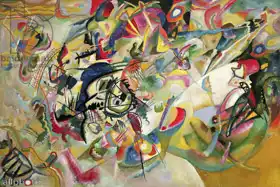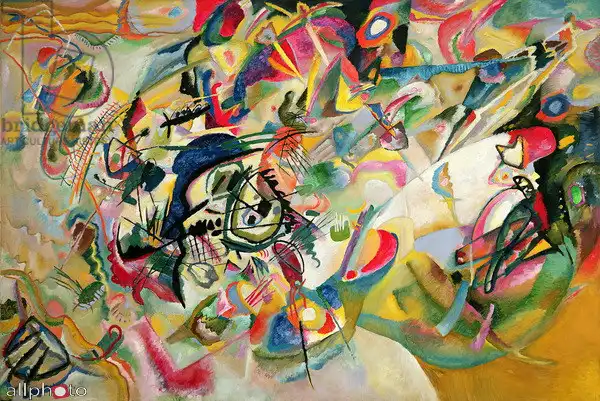About this finishing
Print. The image is printed on the top quality 10-ink HP Z9PS printer on HP matte 270 g / m2 paper. You can choose any size to an accuracy of 1 cm. A margin of 5 cm around the image is added to the size of the motif.


You can find a detailed description about our finishings
here.
Composition no. 7
Date:
1913Medium:
oil on canvas"Composition No. 7" is an oil painting by the Russian painter
Wassily Kandinsky , one of the leading artists of
abstract expressionism and the founders of abstract art. This painting was created in 1913 and is considered one of his major works. The description of this composition is mysterious and even mystical, which is characteristic of Kandinsky's abstract style. "Composition No. 7" is an abstract work, meaning it does not depict specific objects or scenes. Instead, it is composed of geometric shapes, colors and lines that are combined together in a complex pattern.
Kandinsky tried to create images that were abstract and not tied to specific knowledge or objects. "Composition No. 7" is such a work where it is difficult to recognize specific objects, but rather you perceive an emotional and aesthetic sensation. Kandinsky believed that abstract art could evoke deep emotions and spiritual experiences. His compositions are often seen as musical and rhythmic, which is supposed to be his interpretation of the influence of music on visual art.
Kandinsky painted picture Composition no. 7 in 1913. Prevailing color of this fine art print is vivid and its shape is landscape. This image is printed on demand - you can choose material, size and finishing.
Wassily Kandinsky (1866-1944). Russian painter and art theorist. One of the most famous painters of the 20th century. He gained fame through his abstract paintings. After the First World War, he moved to Germany, where he worked until 1933, when he fled the Nazis to France. He lived in France until his death. Kandinsky worked a long way to get to his abstract painting technique (he was fascinated by
symbolism and the psychology of colour). Kandinsky’s most famous works belong to the Bauhaus movement - an artistic movement of the 20s and 30s. It is characterized by sharp, geometric shapes (circles, wedges, triangles, etc.), clear colours and thoughtful treatment of surfaces. Perhaps the most famous work of this era is
Yellow - red - blue (1925).


